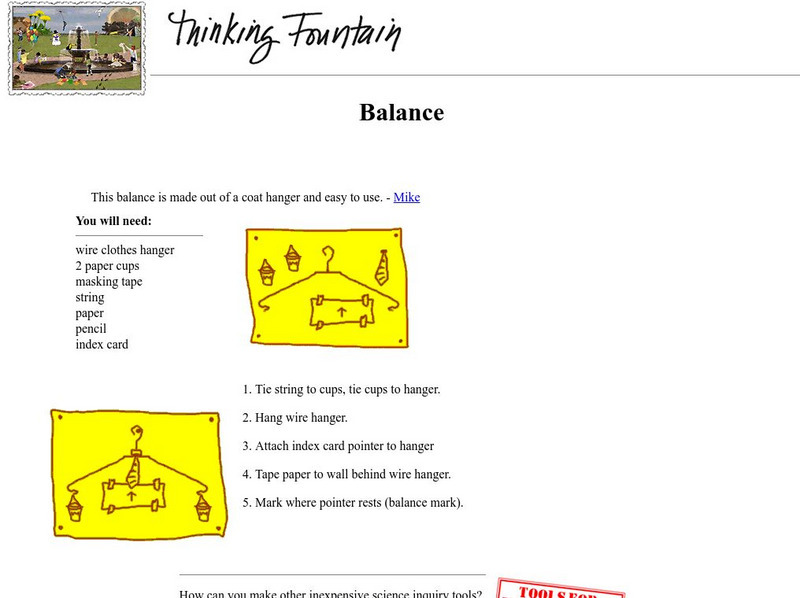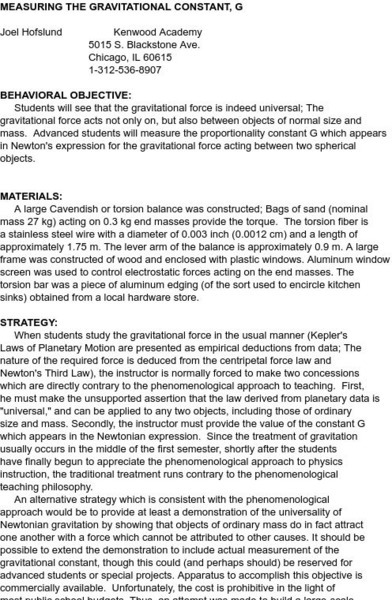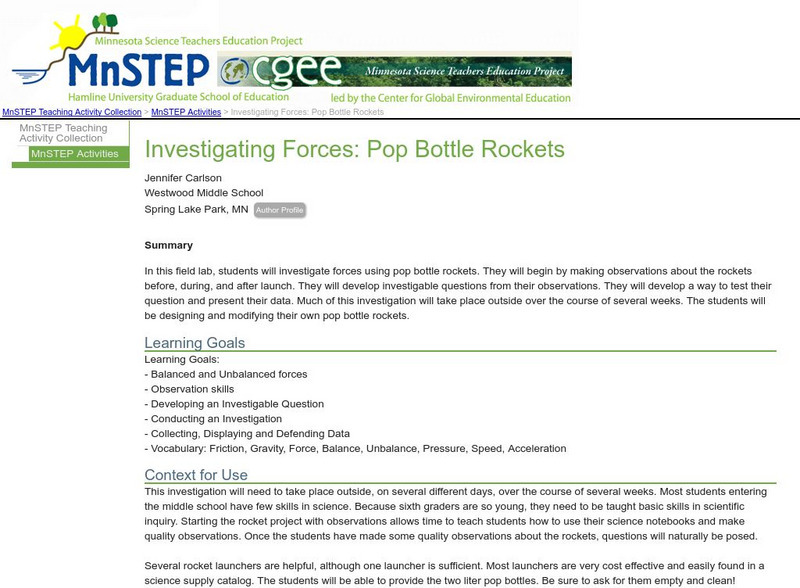PBS
Pbs Kids: Peg the Cat: Happy Camel Game
Help find the camel's toys in bowls of camel food by using a pan balance scale.
PBS
Pbs Learning Media: Earning 100 Snelfus
In this Cyberchase video segment, the CyberSquad figures out how to earn 100 snelfus in 11 days.
American Chemical Society
Middle School Chemistry: Density: Sink and Float for Liquids
Students determine whether a liquid will sink or float in water by comparing its density to the density of water.
Utah Education Network
Uen: Catapult Creations
Third graders learn how a catapult works and build their own.
PE Central
Pe Central: Alphabet Madness
This activity promotes movement through imagery inspired by words associated with each letter of the alphabet.
PBS
Pbs Learning Media: Pedro E. Guerrero Photography Workshop
This media gallery contains video clips from the American Masters and VOCES co-presentation of Pedro E. Guerrero: A Photographer's Journey. The videos are intended for use in a beginner's photography workshop. See the support materials...
PBS
Pbs Learning Media: Sesame Street: Trauma
Trauma can destroy a child's sense of self-worth and confidence in their abilities. Developing new skills, such as balance and focus, can help build it back. These resources offer a variety of ideas to help build a child's self-esteem...
Center of Science and Industry
Cosi Columbus: Bottle "Tops"
Learn about rotation and balance in this hands-on science experiment. Includes full list of materials, procedures, and scientific explanation of how wobbling affects the "spin time" of an object due to it being unbalanced.
PBS
Pbs Learning Media: Solving an Equation for a Missing Value
The CyberSquad solves a number puzzle to help save Motherboard in this video segment from Cyberchase.
PBS
Pbs Learning Media: Making Popcorn Balls (Multiplication)
In this Cyberchase video segment, Bianca uses multiplication to help her adjust the recipe for popcorn balls.
Math Cats
Math Cats: Virtual Mobile
Learn about mobiles, the artwork of Alexander Calder and balance. Read about the topic and then play the mobile building game where you have to balance different sized elements.
Science Museum of Minnesota
Thinking Fountain: The Balance
An easy-to-make, easy-to-use balance that is a great introduction for the elementary student.
Science and Mathematics Initiative for Learning Enhancement (SMILE)
Smile: Measuring the Gravitational Constant, G
A demonstration/lab idea for determining the numerical value of the universal gravitation constant using a torsion balance.
Science Education Resource Center at Carleton College
Serc: Investigating Forces: Pop Bottle Rockets
In this lab, students will work on scientific inquiry skills: observation, developing questions, conducting an experiment, and collecting data. They will investigate forces using pop bottle rockets that they have designed.
Science Education Resource Center at Carleton College
Serc: A Balance Between Art and Science
In this classroom activity, students will use balance to create a beautiful piece of art inspired by artist Alexander Calder.
Science Education Resource Center at Carleton College
Serc: Air She's So Heavy!
During this inquiry activity students will draw on their knowledge of balancing and using an equal arm balance to make discoveries about air!
TryEngineering
Try Engineering: A Question of Balance
Students work in teams to fill jars with a product that is uniform in weight or count. Lesson investigates how manufacturing engineers use weight scales and measurement to develop systems that can create consistent products.
Wikimedia
Wikipedia: Weighing Scale
Definition and explanation of a weighing scale. Includes balances, spring scales, hydraulic scales, and electronic scales.
ArtLex
Art Lex: Balance
ArtLex provides a complete description of the term, "balance," with various links to show how balance relates to art. A work by Vermeer is provided as an example.
PBS
Pbs Kids: Dragonfly Tv: Do It: Balancing Act
An experiment kids can do at home to discover how the center of gravity can affect whether things will balance or not.
Minneapolis Institute of Arts
Arts Connect Ed Artist's Toolkit Encyclopedia: Balance
An interactive site that explores the elements and principles of visual art through the artist's toolkit. This is the encyclopedia entry for balance which covers symmetry and asymmetry, balance with color, and other types of balance.
Minneapolis Institute of Arts
Arts Connect Ed Artist's Toolkit: Balance
An interactive site that explores the elements and principles of visual art through the artist's toolkit. This lesson is on balance (symmetrical and asymmetrical) using "Wrist Guard" by Navajo. The animation shows the arrangement of the...
TED Talks
Ted: Ted Ed: The Hidden Meanings of Yin and Yang
The yin-yang symbol holds its roots in Taoism/Daoism, a Chinese religion and philosophy. John Bellaimey explains why we all contain the spirit of yin and of yang- and how we can achieve a balance of both in our lives. [4:09]
Other
Fun Based Learning: Chemistry: Classic Chembalancer
An exercise for students to practice balancing equations. Exercise gives one equation per page and after the students complete the problem it tells them whether their answer is correct or not. A good basic practice for students who need...















